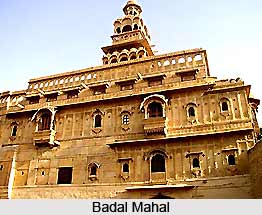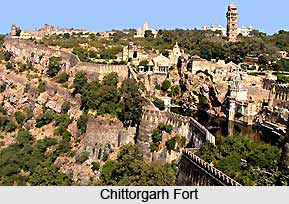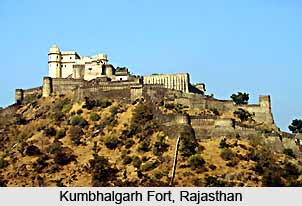 The hill fort of Kumbhalgarh is a spectacular sight, located at a height of 3568 feet above sea level. It figured as the most important fort of Mewar after the Chittorgarh fort. Lying on the topmost ridge of the mountain, this unconquerable fortress is under the protection of the Aravalli mountain range.
The hill fort of Kumbhalgarh is a spectacular sight, located at a height of 3568 feet above sea level. It figured as the most important fort of Mewar after the Chittorgarh fort. Lying on the topmost ridge of the mountain, this unconquerable fortress is under the protection of the Aravalli mountain range.
The fort lies near the village of Kailwara, on the site of a more ancient fortress, possibly built by Sumprit, a Jain prince of the 2nd century. The fort was built by Maharana Rana Kumba in the fifteenth century, and derives its name from the same. Rana Fateh Singh once again rebuilt this palace in the 19th century. The fort has a long history of serving as a refuge to the various rulers of Mewar.
 The approach to the fort is an impressive one, with the need to cross deep ravines and thick jungles. It is encircled by thirteen elevated mountain peaks and is situated on the top most ridges, about 1914 metres above sea level. Seven ramparts, one within the other, reinforced by rounded bastions and huge watchtowers, render the position impregnable. The entire length of then fortifications extends to a length of about thirty six kilometres, giving the fort an international record. It is said to be the second longest wall in the world after the Great Wall of China.
The approach to the fort is an impressive one, with the need to cross deep ravines and thick jungles. It is encircled by thirteen elevated mountain peaks and is situated on the top most ridges, about 1914 metres above sea level. Seven ramparts, one within the other, reinforced by rounded bastions and huge watchtowers, render the position impregnable. The entire length of then fortifications extends to a length of about thirty six kilometres, giving the fort an international record. It is said to be the second longest wall in the world after the Great Wall of China.
There are seven massive gates which guard the approaches. The first gate is the Arait Pol, from which mirror signals could be flashed to the fort in times of emergency. Hulla Pol, the Gate of Disturbance, is next, named after the point reached by invading Mughal armies in 1567, where the mark of cannon shot can still be seen on the walls. The third gate, Hanuman Pol, contains a shrine and temple. The Bhairava Pol has a tablet ordering the exile of a treacherous prime minister in the 19th century. The fifth gate, the Stirrup or Paghra Pol, is where the cavalry gathered prior to battle. The Star watchtower nearby is an early structure with walls 26 ft wide. The Cannon Gate or Top-Khana Pol is reputed to have an underground passage leading to a secret escape tunnel. The last gate is Nimboo Pol or the Gate of Lemon Trees, near which is the temple of Chamundi, one of 365 temples within the fort, before which stands a shrine of the founding ruler.
 The huge complex of the Fort has numerous palaces, temples and gardens making it more magnificent.
The huge complex of the Fort has numerous palaces, temples and gardens making it more magnificent.
The tiers of inner ramparts rise to the summit, which is crowned by the Badal Mahal or Cloud Palace of the Ranas. The palace has several sets of rooms furnished in pastel colours in a 19th-century style. The Cloud Palace holds a fantastic view across the deserts of Marwar. Long sinuous lines of walls with loopholed, crenellated parapets stretch as far as the eye can see along the crown of the hill. The Badal Mahal is the birthplace of the famous warrior Maharana Pratap Singh. The Palace has beautiful rooms with a colour scheme of green, white and turquoise, a stark contrast to the earthy colours of the fort.
No less than 360 temples can be found inside the complex of the fort. One of the finest among them all is the temple of Lord Shiva, comprising a huge Shivling. East of the old Jain temples found within are two royal Chhatris and a temple dedicated to Goddess Kali. One is that of Rani Khumbha, who was murdered here, the other of Prithviraj, a grandson.
The strong structure and solid foundation of the fort have made it an unbeatable structure which remained unconquered over time. The hostile topography of the land had made the fort practically inaccessible. The Kumbhalgarh fort is one of the finest examples of defensive fortification in Rajasthan.



















